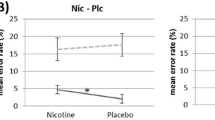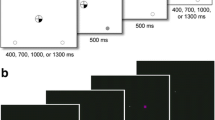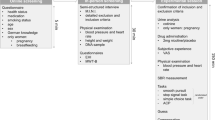Abstract
Ten female subjects (five smokers and five non-smokers) performed a choice reaction time task (CRT), a compensatory tracking task (CTT), a short-term memory task (STM) and were tested for their critical flicker fusion threshold (CFF) at set points over 4 h after the administration of each possible combination of nicotine (2 mg gum or placebo), caffeine (250 mg capsule or placebo) and alcohol (30 g or placebo). Memory and motor function were shown to be facilitated by nicotine or caffeine, and the debilitating effects of alcohol were frequently antagonised by either drug. In spite of the differences in their neuropharmacological actions, combinations of nicotine, caffeine and alcohol may be compared through their effects on common information processing mechanisms involved in psychomotor performance.
Similar content being viewed by others
References
Baker WJ, Theologus GC (1972) Effects of caffeine on visual monitoring. J Appl Psychol 56:422–427
Bonati M, Latini R, Galletti F, Young JF, Tognoni G, Garattini S (1982) Caffeine disposition after oral doses. Clin Pharmacol Ther 32:98–106
Bruce MS, Scott N, Lader M, Marks V (1986) The psychopharmacological and electrophysiological effects of single doses of caffeine in healthy human subjects. Br J Clin Pharmacol 22:81–87
Campbell K, Marois R, Arcand L (1984) Ethanol and the event-related evoked potentials: effects of rate of stimulus presentation and task difficulty. Ann NY Acad Sci 425:551–555
Carpenter JA (1950) Effects of caffeine and alcohol on simple visual reaction time. J Comp Physiol Psychol 52:491–496
Elgerot A (1977) Note on sex differences in cigarette smoking as related to situational factors. Rep Dep Psychol Univer Stockholm 512
Fagan D, Swift CG, Tiplady B (1988) Effects of caffeine on vigilance and other performance tests in normal subjects. J Psychopharmacol 2:19–25
Forney RB, Hughes FW (1965) Effect of alcohol on performance under stress of audiofeedback. Q J Stud Alcohol 26:206–212
Franks HM, Hagedorn H, Hensley VR, Hensley WJ, Starmer GA (1975) The effect of caffeine on human performance, alone and in combination with ethanol. Psychopharmacologia 45:177–181
Frewer LJ, Hindmarch I (1988) The effects of time of day, age, and anxiety on a choice reaction task. In: Hindmarch I, Aufdembrinke B, Ott H (eds) Psychopharmacology and reaction time. Wiley, Chichester, pp 103–114
Gustafson R (1986) Effect of moderate doses of alcohol on simple auditory reaction time in a vigilance setting. Percept Mot Skills 62:683–690
Goodman LS, Gilman A (1970) The pharmacological basis of therapeutics. Macmillan, London
Hamilton P, Copeman A (1970) The effects of alcohol and noise on components of a tracking and monitoring task. Br J Psychol 61:149–156
Hindmarch I (1980) Psychomotor function and psychoactive drugs. Br J Pharmacol 10:189–209
Hindmarch I (1982) Critical flicker fusion frequency (CFFF): the effects of psychotropic compounds. Pharmacopsychiatrica 15:44–48
Hindmarch I (1986) The effects of psychoactive drugs on car handling and related psychomotor ability: a review. In: O'Hanlon JF, de Gier JJ (eds) Drugs and driving. Taylor and Francis, London, pp 71–79
Hindmarch I, Subhan Z, Stoker MJ (1983) The effects of zimeldine and amitriptyline on car driving and psychomotor performance. Acta Psychiatr Scand 68:141–146
Hindmarch I, Kerr JS, Sherwood N (1989) Psychopharmacological aspects of psychoactive substances. In: D Warburton (ed) Addiction controversies. Harwood Academic, New York
Hindmarch I, Kerr JS, Sherwood N (1990) Effects of nicotine gum on psychomotor performance in smokers and non-smokers. Psychopharmacology 100:535–541
Istvan J, Matarazzo JD (1984) Tobacco, alcohol and caffeine use: review of their relationships. Psychol Bull 95:301–326
Jubis RMT (1986) Effects of alcohol and nicotine on free recall of relevant cues. Percept Mot Skills 62:363–369
Knott VJ, Venables PH (1980) Separate and combined effects of alcohol and tobacco on the amplitude of the contingent negative variation. Psychopharmacology 70:167–172
Lee DJ, Lowe G (1980) Interaction of alcohol and caffeine in a perceptual-motor task. IRCS Med Sci 8:420
Leigh G (1982) The combined effects of alcohol consumption and cigarette smoking on critical flicker frequency. Addict Behav 7:251–259
Leigh G, Tong JE, Campbell JA (1977) Effects of ethanol and tobacco on divided attention. J Stud Alcohol 38:1233–1239
Linnoila M, Erwin CW, Cleveland WP, Logue PE, Gentry WD (1978) Effects of alcohol on psychomotor performance of men and women. J Stud Alcohol 39:745–758
Loke WH, Meliska CJ (1984) Effects of caffeine use and ingestion on a protracted visual vigilance task. Psychopharmacology 84:54–57
Lyon RJ, Tong JE, Leigh G, Clare G (1975) The influence of alcohol and tobacco on the components of choice reaction time. J Stud Alcohol 36:587–596
Mangan GL (1982) The effects of cigarette smoking on vigilance performance. J Gen Psychiatry 106:77–83
Matarazzo JD, Saslow G (1960) Psychological and related characteristics of smokers and non-smokers. Psychol Bull 57:493–513
Michel Ch, Battig K (1989) Separate and combined psychological effects of cigarette smoking and alcohol consumption. Psychopharmacology 97:65–73
Mintz J, Boyd G, Rose JE, Charuvastra VC, Jarvik ME (1985) Alcohol increases cigarette smoking: a laboratory demonstration. Addict Behav 10:203–207
Newman HW, Newman EJ (1956) Failure of dextrine and caffeine as practical antagonists of the depressant effect of ethyl alcohol in man. Q J Stud Alcohol 17:267–298
Oborne DJ, Rogers Y (1983) Interactions of alcohol and caffeine on human reaction time. Aviat Space Environ Med 54:528–534
Parrott AC, Winder G (1989) Nicotine chewing gum (2 mg, 4 mg) and cigarette smoking: comparative effects upon vigilance and heart rate. Psychopharmacology 97:257–261
Parsons WD, Neims AH (1978) Effect of smoking on caffeine clearance. Clin Pharmacol Ther 24:40–45
Regina EG, Smith GM, Keiper CG, McKelvey RK (1974) Effects of caffeine on alertness in simulated automobile driving. J Appl Psychol 59:483–489
Russell MAH, Peto J, Patel UA (1974) The classification of smoking by factorial structure of motives. J R Statist Soc 137:313–333
Sahakian B, Jones G, Levy R, Gray J, Warburton D (1989) The effects of nicotine on attention, information processing, and short-term memory in patients with dementia of the Alzheimer type. Br J Psychiatry 154:797–800
Saunders JB, Paton A (1981) Alcohol in the body. Br Med J 283:1380–1381
Schuppel R, Domdey-Bette A (1987) The pharmacokinetics of nicotine and the 14CO2-exhalation rate from radiolabelled nicotine as affected by ethanol. In: Rand MJ, Thurau K (eds) The pharmacology of nicotine. IRL Press, Oxford, pp 34–35
Sherwood N, Kerr JS, Hindmarch I (1989) The use of nicotine gum in psychopharmacological research. Med Sci Res 17:891–892
Sternberg S (1966) High speed scanning in human memory. Science 153:652–654
Sternberg S (1975) Memory scanning: new findings and current controversies. Q J Exp Psychol 27:1–32
Tong JE, Knott VJ, McGraw DJ, Leigh G (1974) Alcohol, visual discrimination and heart rate, effects of dose, activation and tobacco. Q J Stud Alcohol 35:1003–1022
Wesnes K, Warburton DM (1983) Effects of smoking on rapid visual information processing performance. Neuropsychobiology 9:223–229
Author information
Authors and Affiliations
Rights and permissions
About this article
Cite this article
Kerr, J.S., Sherwood, N. & Hindmarch, I. Separate and combined effects of the social drugs on psychomotor performance. Psychopharmacology 104, 113–119 (1991). https://doi.org/10.1007/BF02244564
Received:
Revised:
Issue Date:
DOI: https://doi.org/10.1007/BF02244564




